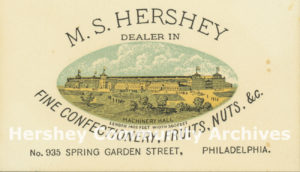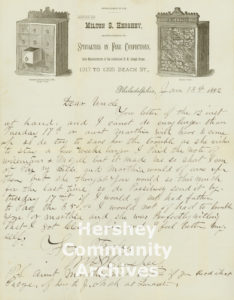Milton Snavely Hershey in Philadelphia, 1876-1882

Milton Hershey’s success as a candy maker came only after several years of struggle and two failed attempts to establish a candy business.
After Milton Hershey completed his apprenticeship with Lancaster confectioner, Joseph Royer, he wanted to open his own candy shop. Not wanting to compete with his teacher, Hershey traveled to Philadelphia in May 1876 to look for a suitable space to rent for his new business.
1876 was an important year for Philadelphia. The city was hosting an international exposition celebrating the nation’s centennial anniversary. Hundreds of thousands of people visited Philadelphia that year to attend the nation’s first world’s fair.
Milton Hershey found a shop to rent at 935 Spring Garden Street, a main pathway to Fairmount Park and the Centennial Exposition. Milton hoped his new business would benefit from the large crowds attending the Exposition. He even printed business cards decorated with an image of the Exhibition’s Machinery Hall.
At first, the candy shop did turn a small profit. As his business expanded, the shop became too small and a few years later Hershey moved down the street to larger quarters at 925 & 927 Spring Garden Street for his retail business. He also established a separate wholesale business located at 532 Linden Street. Milton worked long hours. Many nights he did not go home, but slept at the store under the counter.
Instead of concentrating on one product, Hershey produced a variety of goods in an effort to appeal to everybody. Besides candy, he sold fruit and nuts. He made ice cream. On the Fourth of July one year he paid a German Band to play in front of the store while he served ice cream at five cents a plate to the crowd that had gathered to listen to the music.
Confectionery competition in Philadelphia was fierce. Milton Hershey’s product line was good but the volume of candy produced was too small to make much of a profit. He had neither the equipment nor a large enough staff to permit him to mass produce and distribute enough candy to make money out of penny goods. Though his sales kept up with production, Hershey was not able to earn enough to keep ahead of his bills. The sugar dealers that supplied his ingredients demanded cash in payment while his wholesale customers expected credit and were slow to pay their bills. Hershey fell behind paying his bills, and lived in fear of impatient sugar dealers suddenly cutting off his supply of raw ingredients.
As Milton Hershey tried to grow his business, he needed help. In 1880 he hired Harry Lebkicher, who had worked on been a clerk in a Lancaster lumberyard.
In 1881 his father, Henry Hershey, arrived. It is said he worked for his son peddling candy because he wanted to help his son make a good start. Henry Hershey was a man of both imagination and action. “If you want to make money,” he said to his son, “you have got to do things in a big way.”
To support his son’s business, Henry Hershey designed a new a new candy display cabinet for his son to market. He also developed a formula for cough drops that he encouraged his son to produce. In the December 1880 issue of the Confectioners Journal, Milton Hershey placed a large ad featuring the candy cabinets and cough drop candies.
Henry Hershey’s ideas would spread his son’s resources too thin. There was not enough money to invest another venture. Investing in his father’s idea, Milton Hershey slid further into debt each month. Hershey appealed to his mother’s brother, Abraham Snavely, for repeated loans. At first Abraham loaned his nephew the requested monies, but he soon decided that loaning his nephew more and more money was not a smart idea.
After operating his first candy shop for six years, Milton Hershey’s first business venture collapsed in bankruptcy. While the end of this business was not happy, Milton Hershey learned many lessons about supply and demand, credit, cash flow and the importance of limiting your product line. These were all lessons that he would put to use more profitably in future business ventures.
